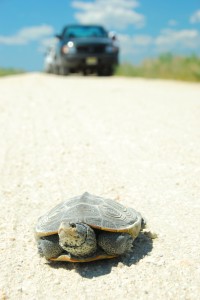Its Terrapin Week!
Join us on this fascinating journey into the world of the Diamondback Terrapin
Last week, I drove slowly down a road with no buildings or homes on either side, with only vast salt marsh as far as the eye could see. Over the course of the roughly 10-mile round trip, I passed maybe four other cars. But there was another kind of traveler that I found in abundance – 22 diamondback terrapins crossing the road on the way out, and another 18 of these gorgeous turtles on the way back (although I’m sure I saw some of them twice)!
Amazingly enough, this was a drive along the New Jersey coast in June. If you haven’t guessed it, I was on Great Bay Boulevard in Little Egg Harbor. And if you haven’t been there, now is the time to go – it is a true wildlife spectacle that you have to see to believe.
New Jersey’s coast is filled with wonders during the summer months – wonders that go beyond its crowded beaches, boardwalks, and traffic jams! Believe it or not, the coast still has plenty of nature to be found, often in total seclusion. And diamondback terrapins offer as amazing a wildlife story as any.
So today we kick off Terrapin Week! Read our first installment below for an up-close look at the terrapin’s habitat, appearance, range and status. Then stay tuned for a brand new story each day this week by our terrapin biologists Ben Wurst and Stephanie Egger, with topics including our biologists’ research projects, how our volunteers are making a difference, terrapins across the East Coast, and New Jersey locations where you have the best chance of seeing terrapins in the wild!
David Wheeler
Executive Director, Conserve Wildlife Foundation of NJ
Meet the Terrapin
by Stephanie Feigin, CWF Program Coordinator
Northern diamondback terrapins (Malaclemys terrapin terrapin) are native to New Jersey and inhabit the many miles of coastal salt marshes and estuaries along the Atlantic Coast and Delaware Bay. They exclusively inhabit coastal salt marshes, estuaries, tidal creeks and ditches with brackish water (a mix of both salt and freshwater) which is bordered by spartina grass. They are the only turtle species in the world that is specially adapted to spend its entire life in this type of water.

The northern diamondback terrapin is a medium-sized turtle that varies in length from only 4 to 5.5” in males to 6 to 9” in females. Terrapins have a gray, brown, or black carapace (top of shell) and a lighter plastron (bottom of shell), which is a greenish-yellow. The skin is light to dark gray with black spots and other dark markings. Both sexes have a light colored upper mandible. They are named for their diamond shaped pattern on their carapace. Adult terrapins primarily eat mollusks and crustaceans, including snails, fiddler crabs, and mussels. They also eat blue crabs, green crabs, marine worms, fish, and carrion.
Terrapins are cold-blooded, or ectothermic. They hibernate during the winter and bury themselves at the bottom of or in the banks of creeks and ditches. Studies have shown that terrapins also exhibit a high level of site fidelity or they return to the same territory every year, some even occupy the same small creeks year after year. Terrapins have a very small home range, from Cape Cod, Massachusetts to Cape Hatteras, North Carolina.

In 2001, a status review of reptiles in New Jersey recommended that the Northern diamondback terrapin be listed as a species of special concern in New Jersey. The listing as special concern “warrants special attention because of some evidence of decline” (NJ ENSP-Species Status Listing) and little is known about their actual population status in New Jersey. However, terrapins are still harvested for food in New Jersey and the total harvested annually is not known. Since Terrapins are still considered a “Game” species subject to harvest, the Special Concern designation was never officially applied to the species and will not be until they are re-classified as a “Non-game” species.
Major threats to the health of the population include; habitat loss, mortality from being drowned in crab traps, and road mortality. Each year hundreds of terrapins are killed by motor vehicles throughout their range and here in New Jersey. The Conserve Wildlife Foundation (CWF) and their biologists are working hard to protect these incredible reptiles with their many conservation efforts. We are asking you to “Be Terrapin Aware” while driving along roads in New Jersey’s coastal region, and stay tuned for more posts during Terrapin Week about our efforts to protect these turtles!
Discover more from Conserve Wildlife Foundation of NJ
Subscribe to get the latest posts sent to your email.
Leave a Comment
Hi. I believe I saw a Raccoon eating a Terrapin on the Wildlife Drive in Forsythe this past Thursday. The turtle was on its back while the Raccoon was pulling at its legs, so it was hard to tell if it was a Northern Diamondback or not. The Raccoons may be another reason why their population is decreasing? Was very sad to see and there was not much I could do because the Raccoon was not being scared off and I could not get out of the car because of the situation.
Hey Angela, How interesting! For a raccoon to be active during the day is not normal, so it could have been rabid. Most likely it was a terrapin. They’re the most common species of turtle that you would see near the coastal saltmarsh. The other species that uses it only infrequently, is the common snapping turtle. Raccoons do predate a lot of nests, but the biggest threat to terrapins is ghost crab pots, which trap an unknown number of them (and many other species, including blue claw crabs) each year.
Comments are closed.